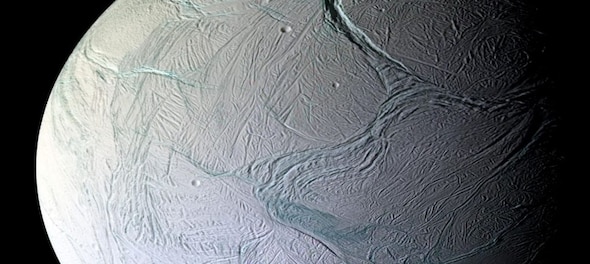
Finding signs of extra-terrestrial life, even if it is unicellular or microbial, is one of the biggest goals of astronomers and scientists. While our neighbouring Red Planet gets most of the attention, 1.2 billion km away from the Earth orbits the most likely candidate to house life in the solar system.
With the presence of H2O, the chemical composition of its vast hidden oceans, and plenty of geological activity, Saturnian moon Enceladus is one of the leading candidates to have signs of life in our local neighbourhood of space. While icy planets are common in space, what makes Enceladus unique is the fact that under the kilometres-thick icy shelf are thought to be vast oceans of water. Plumes of water are shot hundreds of kilometres into space through geysers indicating there are significant enough sources of internal heat within its vast oceans and the moon is geologically active.
This makes Enceladus one of the prime locations where scientists hope to find signs of life outside of our own planet. Further research into the moon’s chemistry has made scientists excited about this icy moon’s capacity to host some signs of life. Its oceans are thought to be rich in phosphate, a key ingredient necessary for the basic building structure of all life - genetic material like RNA and DNA.
Orbiting Saturn, scientists have found that the moon which is famous for its plumes of water and ice may have been even more active in the past. While the planet is icy, it is also covered in a deep layer of snow on its surface, which enhances its characteristic reflectiveness. The snow is believed to be as deep as 700 m in some spots. By comparison, the deepest snow ever measured on Earth was just 11 m. With a diameter of just 504 km, the snow could make up 0.13 percent of the Moon’s diameter.
ALSO READ:
Emily Martin and her team of planetary scientists stated in a new study that the thickness of the snow suggests that Enceladus’s plumes were far more active in the past. Her research, which is published in the March 1 issue of the science journal Icarus, tries to understand the surface of the satellite using the help of the geology that can be seen. Without the help of any landers or orbiters touching down, it is hard for scientists to understand what kind of surface awaits them when trying to land on Enceladus.
Completely surrounded by a shell of ice measuring 20 to 25 km on average, about 2.25 to 2.8 times taller than Mount Everest, Enceladus is far from the largest moon in the Solar System. The moon is the sixth-largest moon orbiting Saturn and is the 19th-largest in the Solar System. The icy surface makes the moon one of the most reflective surfaces in our system.
The US National Aeronautics and Space Administration (NASA) recently shared a mesmerising picture of the Saturnian moon Enceladus. The cold and icy moon was captured by the space agency’s Cassini spacecraft during a flyby. Cassini’s last flyby of the moon was in 2015, and the spacecraft captured hundreds of pictures of Enceladus before it was decommissioned by flying into Saturn.
The image shows the icy moon’s south polar region as captured by Cassini during one of its many flybys. The image, enhanced to bring out the colours more sharply, shows deep and large craters speckled around the surface. Deep blue cracks that look like veins run throughout the surface. As Enceladus is about 1.5 billion km away from the Sun and at a distance of 240,000 km from Saturn, the moon cannot be seen fully as its far side remains perpetually trapped in darkness.
As part of its 2023-32 Planetary Science Decadal Survey, NASA proposed a flagship mission to Enceladus last year. The Enceladus Orbilander would spend nearly two years orbiting the moon before landing on its surface for a two-year-long survey. It was classified as the third highest priority mission by the space agency. The European Space Agency is also considering a proposal for an Enceladus mission that will see a spacecraft collect physical samples from the moon.
(Edited by : Sudarsanan Mani)
First Published: Jan 18, 2023 2:31 PM IST
Check out our in-depth Market Coverage, Business News & get real-time Stock Market Updates on CNBC-TV18. Also, Watch our channels CNBC-TV18, CNBC Awaaz and CNBC Bajar Live on-the-go!


Lok Sabha Elections 2024 Live Updates Phase One: 1,625 candidates in 102 seats across 12 states, UTs in the fray
Apr 19, 2024 6:17 AM
Lok Sabha election 2024: A SWOT analysis of DMK vs AIADMK in Tamil Nadu
Apr 19, 2024 1:22 AM
Exclusive: FM Nirmala Sitharaman says poverty alleviation can't be achieved by throwing money at the problem
Apr 18, 2024 7:27 PM
Tamil Nadu Lok Sabha elections 2024: List of Congress candidates
Apr 18, 2024 4:33 PM

